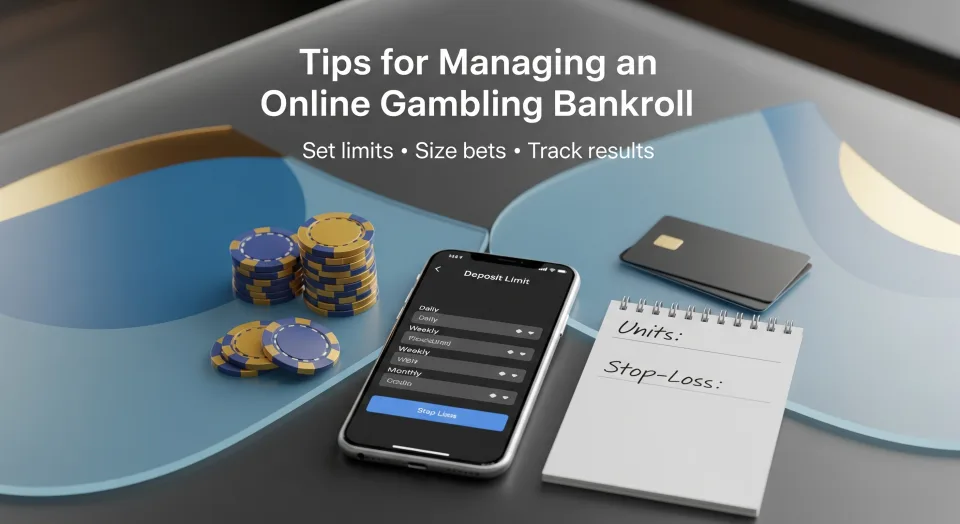Tips for managing an online gambling bankroll start with one mindset: your bankroll is a budget for entertainment, not a bottomless credit line. Treat it like a season ticket—fixed cost, planned usage, clear rules. Below you’ll find a practical framework you can apply to slots, table games, live dealer, and poker, including session planning, bet sizing, tracking, and recovery steps if things go off-script.
1) Define the bankroll (and ring-fence it)
A bankroll is money set aside solely for gambling—separate from bills, savings, and everyday spending. Moving it into a dedicated account or wallet creates a psychological and practical barrier. This is the single most effective of all gambling bankroll tips because it prevents “just top up from rent money” moments. If you’re using bonuses, remember that wagering requirements and game-weighting can stretch or shrink how far that bankroll goes.
2) Choose a session budget and schedule
Break the total bankroll into sessions (e.g., four sessions per month). Each session gets a fixed budget and a fixed time window. End the session when money or time runs out—whichever comes first. Sessionizing adds natural pauses, which helps you avoid tilt and review results with a clear head.
-
Monthly example: $400 bankroll → 4 sessions × $100
-
Weekly example: $200 bankroll → 2 sessions × $100
If you enjoy live dealer or higher-volatility slots, consider smaller stakes over more spins to smooth variance.
3) Size bets with simple math (bankroll × risk profile)
A fast way to size bets:
-
Low volatility / learning: bet 0.25%–0.5% of bankroll per spin/hand
-
Moderate: 0.5%–1%
-
High volatility / features: 0.2%–0.5% (more conservative)
Example: $400 bankroll, moderate risk → 0.5% = $2 per spin/hand.
On table games, think in units (e.g., $2 units). Your stop-loss and win goals are measured in units too.
Pro move: never reduce the number of lines/ways on slots just to bet bigger. Keep coverage; adjust the bet per line instead.
4) Set three hard limits before you play
Pre-commit these in the cashier/app:
-
Deposit limit: caps how much new money you can add (daily/weekly/monthly).
-
Loss/stop-loss: the most you will lose this session (e.g., 5–10 units).
-
Time limit / reality check: nudges you to evaluate, not autopilot.
Use the site’s tools in the “Limits” or “Responsible Gambling” area—these are there to support tips for managing an online gambling bankroll, not to slow you down.
(For impartial guidance, see practical responsible gambling advice on BeGambleAware.)
5) Pick games that fit your tolerance (RTP, volatility, hit rate)
-
RTP: Higher long-run return means gentler drain on average.
-
Volatility: High-volatility slots and some table side bets swing wildly; stake smaller to survive dry spells.
-
Hit rate & features: Frequent small wins feel good but don’t guarantee profit; read the paytable and feature rules first.
If you’re learning roulette or blackjack, understand the house edge. On roulette, European (single zero) is kinder than American; in blackjack, basic strategy reduces edge significantly. These choices matter for bankroll longevity.
6) Use bonus offers intentionally (or skip them)
Bonuses can extend play, but only if the rules match your plan. Check:
-
Wagering multiple and what it applies to (bonus-only vs deposit+bonus vs free-spin wins).
-
Game weighting (tables often count less than slots).
-
Max bet while wagering and time limits.
-
Sticky vs non-sticky: with non-sticky, you can withdraw real-money wins before touching the bonus.
If a bonus forces stakes that are too high for your unit size, skip it. Your bankroll plan beats a poorly matched promo.
7) Track results like a bookkeeper (it takes 2 minutes)
Open a simple sheet or notes app and log:
-
Date, game, stake size/units
-
Deposits/withdrawals (net result)
-
Session duration and feel (calm/tilt/fatigued)
Patterns will jump out fast—e.g., “high-volatility slot at $1 is too spiky; $0.40 keeps me in the game.” Tracking is the quiet engine behind most gambling bankroll tips.
8) Adopt stop-loss and stop-win targets
-
Stop-loss example: 5 units in a session.
-
Stop-win example: +5 to +10 units or a feature hit.
Hitting either target means stop. Locking up wins keeps variance from taking them back on the next downswing.
9) Recover smartly (the anti-tilt routine)
If you breach a limit, the next steps are automatic:
-
Timeout (e.g., 24–72 hours).
-
Review the log for what drifted (stakes, game choice, fatigue).
-
Adjust stakes down one step next session or shorten session length.
-
If urges feel strong, increase limits strictness or consider a self-exclusion period.
Clear rules beat willpower after a rough run.
10) Payment methods that help control
Credit encourages overspend and may add fees. Skrill or debit can limit deposit exposure and speed up withdrawals, which supports tips for managing an online gambling bankroll by making it easier to ring-fence funds and cash out promptly. Always verify you’re on a licensed site and that limits are easy to set in the cashier.
(For general player-protection standards, see your jurisdiction’s official gambling regulator public register at the UKGC: Public Register.)
11) When to walk away (and how to close an account)
If you regularly break limits or feel pressure, use the site’s account closure or self-exclusion tools. You can also set longer cooling-off periods and lower deposit caps to prevent impulsive returns. Recognizing problem gambling habits early protects both your bankroll and your wellbeing.
Quick FAQs — Bankroll management
How big should my bankroll be?
For casual play, 40–100 units is a healthy baseline (e.g., $0.50 units → $20–$50 session; $2 units → $80–$200 session). Increase units only after consistent results with your current plan.
Is chasing losses ever sensible?
No. It converts a bad session into a bad month. Stick to stop-loss, take a timeout, review, and resume with smaller units.
Do higher RTP games guarantee wins?
No. They reduce average drain. Variance still applies: structure sessions and limits accordingly.
How often should I withdraw?
Small, frequent withdrawals help you bank gains and reset to base units next time.
Final checklist (copy/paste)
-
Ring-fenced bankroll and session budgets
-
Unit size set (0.25%–1% per spin/hand)
-
Deposit, loss, and time limits enabled
-
Game choice aligned with RTP/volatility tolerance
-
Bonus rules compatible with your unit size
-
Quick session log after each play
-
Stop-loss and stop-win respected; withdraw regularly
By applying these tips for managing an online gambling bankroll, you’ll turn vague intentions into concrete rules—so sessions stay fun, losses are contained, and wins actually make it off the site and into your pocket.

